Studio - Log
Entries from 2013
Move of the Studio
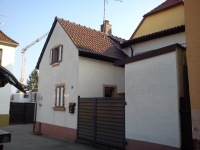
The new Studio in 3. Querstrasse
 nach oben
nach oben
Entries from 2010
Opening of my new Studio
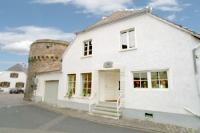
The new Studio in Wallstrasse, close to the Irongate (Eisentor)
Since September 11th, in 2010, my new studio in the lovely village of Freinsheim is open.
 nach oben
nach oben
Entries from 2007
Tamadare
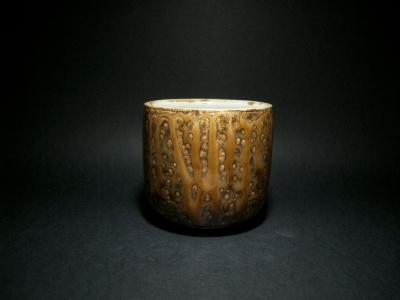
Bowl with Tamadare-Glaze containing iron-oxide
Tamadare (jpn: tama - Drop, dare - running) are effects
which appear only when firing with wood.
While burning wood ash flows through the kiln,
deposits and melts on the surface and lets this effect
appear. Lines and pattern of glaze show-up and at
the bottom droplets of glaze appear.
Now I have managed to create a wood-ash glaze which
produces this effect while firing ceramics in an electric kiln.
This process is under control and repeatable.
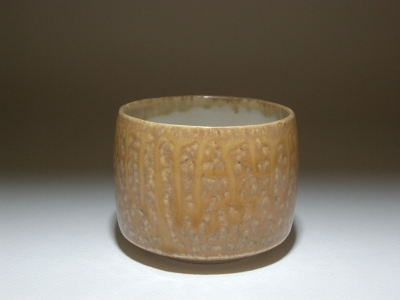
Bowl with Tamadare-Glaze containing titanium-oxide
Tamadare develop in a wood-fired kiln because of the
ash spinning around. No changes in colour are
possible.
Changes of colour can only be archived through
interaction with the clay-body or by insertion of
salt during firing - but both ways are hardly to control.
I can change the colour of the Tamadare because I created
a glaze, which can be modified like any other by adding
metal-oxides.
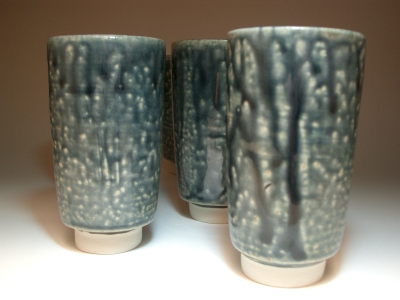
Bowl with Tamadare-Glaze containing cobalt-oxide
 up
up
New Kiln
By end of 2006 I had to realize, that my 20 years old kiln
did not work proper anymore. So I was forced to buy a new one.
Just replacing the heating-elements could have been
a temporary solution, but during the course of time
the insulation was also flawed and this is no simple task
to replace.
Now I've found out, that the kiln, even larger in volume,
has a lower energy consumption - a nice side-effect.
Equiped with a controller, which allows me to fire any
imaginable temperature curve and a maximum firing range
up to 1320°C, I hope to be on the safe side for the
future.
 up
up
30 Years
It all started 30 years ago.
By self-education I run into clay, a material new to me,
and begun to throw my first pots.
Like before, most of work is done with clays from the Westerwald area.
Of course, I also try other clay bodies and techniques, but the enthusiasm for throwing remained until today.
 up
up
An Accident!
Because my ball-mill had meanwhile come to an age, it wasn't a surprise, that it broke.
After I've managed to get a new motor and wanted to continue with grinding of Orkney rocks ...
... it happend!
The jar mill slipped out of my hands and broke.
Due to the fact, that these pots had a price increase during recent years like oil I currently can't buy a new one.
So, that is, for the time being, the end for my rock glazes.
 up
up
Entries from 2006
My new Studio!
My new studio is now located in Worms, Friedrich-Ebert-Strasse 119. In earlier times this has been a hairdresser's salon.
The redecoration was a lot of work and coined by several surprises: the coming down of a 1cm thick layer of wallpaper from the ceiling was the clou.
But with help from friends and support of the owner the hard work came to an end and finally I could begin to think about my pottery.
Like before, most of work is done with clays from the Westerwald area and I make heavy use of ash- and rock glazes, fired up to 1240°C.
Further on I use stoneware clays from England and porcelain from France and Australia.
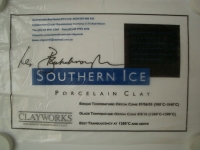
Porcelain from Australia - really expensive!
Currently I use my jarmill to prepare shell sands and rocks from Orkney, Scotland, where I stayed during my last holidays.
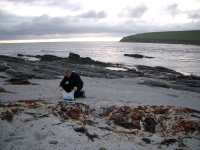
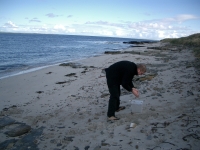
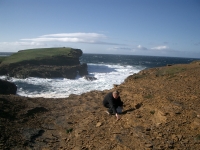
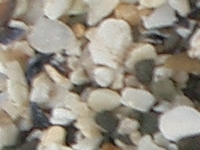
"It should be possible to reproduce the rough nature within glazes."
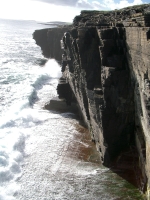
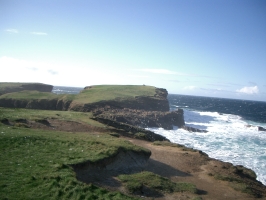
Most of my works are made with the potters wheel. Sometimes the vessels are getting deformed or treated with various tools - suited to do the job or not.
If the pieces are dry, they were put into the kiln for a first firing at around 960°C.
Next, I glaze all pieces. My glazes are composed of feldspar, flint, whiting and a lot of ashes or rock powder.
By adding iron, manganese, copper, titanium and cobalt the glazes produce colors ranging from a metalic black to an earthy brown or red up to nearly white.
The final firing is also done in an electric kiln at around 1240°C.
The most thrilling moment comes, when the kiln is ready to be opened and I can have a first look inside:
"Did everything went well?"
"Has everything survived the enormous impact of temperature?"
"Are the glazes the one I intended?"
Give yourself a chance for a surprise and drop by. You're always welcome to visit me.
 up
up
